We are often asked what firearms we recommend for home defense, and based on the circumstances, we often say that a shotgun may be the best choice for a number of reasons: ease of operation, stopping power, and multi-shot capacity, to name three. Most shotgunners know that defense shotguns have long held 5, 6, 7, and 8 rounds, usually in tubular magazines under the barrel. But there are bigger-capacity shotguns out there, and we recently had a chance to test four of them.
Our test guns were the Akdal Arms MKA 1919 3-inch 12 Gauge, $799; the Kel-Tec KSG 3-inch 12 Gauge, $1075; the Saiga IZ-107 12 Gauge, $640; and a Red Jacket Saiga RTS-SBS-12 Short-Barrel 12 Gauge, $1939.
The KSGs popularity has grown exponentially since it was announced in 2011, part of which is driven by its inclusion in shooter video games, including the most recent Call Of Duty: Modern Warfare 3, and it is rumored to be returning for Call Of Duty: Black Ops II. The KSG is a bullpup pump shotgun whose short overall length of only 26.1 inches allows for greater maneuverability and makes it suitable for close-quarters combat.
The Akdal MKA 1919 is a gas-operated semi-automatic shotgun that was created by a Turkish company called Akdal Arms. The 1919 is designed to look and feel like the AR-15 rifle. The gun comes stock with a polymer AR-style fixed front sight and polymer carry handle that has a built-in flip sight. Both the front and rear sights can be removed if you like to customize your guns and add your own optics. The upper receiver is made of an aluminum alloy, and has a Picatinny rail that runs along the top. The lower half of the gun is a single polymer piece that is both the grip and a fixed stock that has a rubber buttpad already built in.
Our older Saiga 12, still in Very Good shape, was manufactured at the Izhmash Factory in Russia and imported through EAA Corp. What we believe is an identical gun, the IZ-107 12 Gauge, $640, is available from K-Var Corp. of Las Vegas (K-Var.com, [702] 364-8880). Because its currently available, we listed K-Vars model number throughout. So you can either look for a used gun like ours, or if you want a brand-new gun of this type, you know where to start. Designed as an all-purpose shotgun, this Saiga comes with a chrome-lined barrel which allows the use of many different types of ammunition, including steel. The Saiga 12 is capable of cycling both 23⁄4- and 3-inch magnum shells. As with all Saiga 12s, this shotgun is not designed to use low-pressure shells. Saiga 12 gauges now come standard with the bolt hold-open feature. This allows for a quicker change time between magazines. This shotgun was manufactured utilizing the Kalashnikov gas system. This gas system reduces felt recoil dramatically.
Our fourth gun, the Red Jacket Saiga, was the most expensive by far and was the worst performer, our testers said. They simply couldnt make the gun work very well. This was a loaner gun from our home test facility, Tactical Firearms in Katy, Texas (TacticalFirearms.us), who had bought the RJS in both compensated and suppressed forms. The Tactical Firearms staff called it the Red Junket instead of the Red Jacket Saiga because they could rarely fire more than a couple of shells before the action locked up in several different ways, which we describe below.
Because the Saigas are only supposed to use 1.25-ounce or heavier shotcharges, we fired them mostly with 12 gauge Winchester Super-X Game and Field Loads (23⁄4 inch #6 Lead, 11⁄4 ounce, 1330 fps), which we bought at Cheaper Than Dirt! for $16.51/25, #2-WNX126BX. Other CTD loads we used included Hornady Zombie Z-MAX 00 Buckshot rounds (23⁄4 inch, 8 pellets, 1600 fps, $10.29/10 #AMM-8212); and Fiocchi Exacta Aero Slugs (23⁄4 inch lead, 1 ounce, 1560 fps), which cost $7.91/10, #6-0309542. We also fired Remington Slugger 3-inch 1-ounce rifled slugs ($5.34/5 @ 1760 fps, currently out of stock); and Winchester Supreme Partition Gold 3-inch 385-grain sabot slugs SSP123 ($12.55/5 @ 2000 fps, also out of stock).
Our plan was to shoot all four shotguns for function and to check features, then shoot groups with the slugs to compare their accuracy. However, the second part of that turned out not to be necessary because we had function trouble with the Akdal, KSG, and Red Jacket guns, making the Saiga the winner by default.
We describe the problems we had in fuller detail below.
Red Jacket Saiga RTS-SBS-12 Short-Barrel 12 Gauge, $1939
The Red Jacket website, RedJacketFirearms.com, lists several firearms conversion menu choices, one of which is AK Type Shotguns. In that segment, the company lists nine AK variations, with the least expensive being the RTS-ZK-410 in .410 bore, $1725, and the most expensive being the RTS-ZK-S/S-12, $2995, which includes a suppressor. According to Tactical Firearms GM Jeremy Alcede, our test gun was originally the high-end $3,000+ gun with suppressor, but the suppressor that came with the gun had the wrong thread pitch, he said, so we couldnt even screw it on! And it took over a year to come in, not six months. Estimated delivery of RJF Firearms is six months, according to Red Jacket website. Without the suppressor, our test gun most closely resembled Red Jackets RTS-SBS-12 Short-Barrel unit, which is fitted with a muzzle brake.
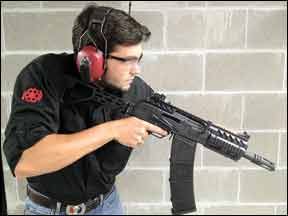
In the How to Buy section on the website, RJF makes it clear that the buyer must find a local FFL to receive the firearm. RJF also charges a 10% deposit plus shipping on purchases over $500, with the balance collected prior to shipping. For NFA items, RJF will collect the balance when transfer paperwork has begun. Thats all pretty standard and reasonable, in our view. The gun itself is tricked out. It comes with an installed Chaos rail system. The Chaos top rail is hinged and is held in the rear by the top cover/recoil spring assembly. On our sample, we detected very little lateral movement in the rail system and only a slight bit of vertical movement, with just enough tension at the joint to allow the top cover to stay in place when lifted up. The rail is attached to the rifle in a few places, so theres very little shake.
Up top, the HK-style drum base and rear sight is nicely machined, and the rear sight doesnt bind. It engages each position with an audible and tactile click. The front is an HK-style shrouded sight. The buttstock is an RJF Billet sidefolder stock, and the action has a welded-on RJF upswept charging handle. Out front, there was a muzzle brake with sharp compliance tips, and the gun came with a single 5-shot Saiga magazine.
Tactical Firearms loaned us two of the RJF Saigas, and both exhibited the same problems. First, the folding stocks didnt work properly. The joints where the stock folded wouldnt always lock out, so the stock would collapse upon firing. Also, the stocks wouldnt stay closed. Additionally, both guns exhibited rough workmanship in visible areas. There were obvious and significant scratches on the receiver and the exposed part of the bolt. Wear spots were immediately noticeable, and some of the spots had been covered by permanent marker.
Most worrisome to us were ongoing malfunctions. We basically could not get either RJF to run with the supplied 5-rounds or the other higher-cap Saiga magazines we had for it. We got double feeds, failures to feed, failures to eject, and stovepipes with every ammo we tried in it. The basic Saiga gun didnt exhibit any of these problems.
Our Team Said: The Red Jacket Saiga RTS-SBS-12 Short-Barrel 12 gauge was pricey and didnt work during our testing.
Akdal Arms MKA 1919 3-Inch 12 Gauge, $799
Although the MKA 1919 is new on the U.S. shooting scene, its not a brand-new gun. Ucylidiz Arms AS, located in Istanbul, Turkey, has been producing this gun since 2007. The 1919 is a semi-automatic shotgun designed to look and handle like an AR-15 to reduce training time and preserve muscle memory when switching over from an AR. From a distance the 1919 could probably pass as a AR-15. Our test shotgun came from Fountain Firearms in Houston, FountainFirearms.com.
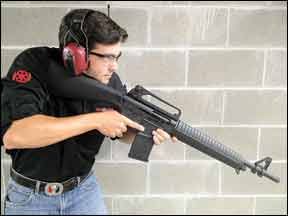
You can purchase the Akdal 1919 in the matte black finish, but it also available in a camo print, which is about $100 more. The upper receiver is manufactured from an aluminum alloy, while the lower receiver, along with the pistol grip and shoulder stock, is manufactured as one piece from impact-resistant polymer. The Akdal has a 5-round detachable-box magazine, and the magazine catch is identical to the M16 magazine catch and is located on the upper receiver. To charge the shotgun, the charging handle on the receiver needs to be pulled.
The manual safety is located on the left side of the gun and flips just like it would on the AR-style rifle. Some testers said the guns safety felt soft, and that they would prefer more of a solid click to give a better feeling of it locking in to place. We did not notice this issue on our gun any of the times that we had to cycle the safety.Standard sights include a front post installed on the M16-style removable base and a detachable M16A2-style carrying handle with built-in diopter sight. On the upper receiver, an integral Picatinny rail can be added, which will accept a detachable carrying handle or optional red-dot or other optical sight attachments.
The 19.7-inch chrome-lined barrel is threaded for removable chokes. A Cylinder bore, Modified and Full choke tube set are provided with a choke case and wrench. The conventional gas-operated action is located around the support tube that runs below the barrel. The return spring is also located around the same support tube, which is concealed by an enlarged polymer handguard. The MKA 1919 barrel can be quickly removed from the upper receiver. When we hit the range with the Akdal, we very surprised at how light the gun was. The polymer frame really makes the gun a breeze to shoot. But with lightweight shotguns, you usually pay the price of what you saved in weight with kick from the gun. But much to our surprise, we had no issue shouldering the gun, and we were not blown away by recoil from any of the rounds that we fired through the gun.
The MKA 1919 will chamber and fire factory 23⁄4-inch or 3-inch shotshells, which can be stowed in one magazine for 23⁄4-inch shells and a second for 3-inchers. The magazines hold the bolt open after the last round is fired.
We did, however, have a lot of failures to eject, in which the shells would either not leave the chamber after they were supposed to have been ejected or they would catch on the action on the way out. The manufacturer recommends a three- to four-box break in period with birdshot loads. The owners manual suggests using high-powered slugs for the break in period. So we put three boxes of Fiocchi high-powered slugs through the gun then switched back to the Winchester loads and had the same issue, so bad that we could not get through one of the 5-round magazines without having a jam. So we put another three boxes of Fiocchi slugs through the gun. After the sixth box of high-powered ammo, we were able to get through most 5-round magazines after that without an issue.
Our Team Said: The MKA 1919 looks a lot like an AR-15, but because none of the moving action parts are located in the shoulder stock, it could be fitted with a six-position stock. That would be an interesting upgrade on the shotgun, which would make it feel even more like its single-projectile counterpart. Like our views of the Red Jacket, we were torn about scoring this gun where its malfunctions should put it. Were not sure what fixes are needed to make it cycle reliably – the problems diminished but didnt disappear at the end – but if youre willing to work them out, this is an intriguing choice.
Kel-Tec KSG 3-Inch 12 Gauge, $1075
The KSG (Kel-Tec Shotgun) is Kel-Tec CNCs first entry into the shotgun market. Its size, shape, and design are similar to the RFB rifle, but the KSG ejects downward, instead of forward. The KSG weighs a shade over 7 pounds and measures only 26.1 inches long, as compact as legally possible without NFA papers. But capacity is the real story here. The internal dual tube magazines hold an impressive 14 rounds of 12 gauge 23⁄4-inch shells (seven per tube) and 12 3-inch rounds (six per tube).
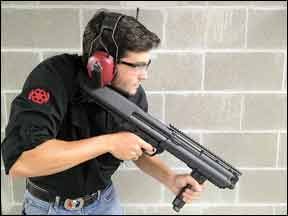
Well get more into the functional details shortly, but first we need to disclose some confusion about the two models of KSG we tested. Our first gun was loaned to us, but we didnt know it was one of 50 early pre-production guns. But because we seem to attract all the bad guns in the marketplace – a statistical miracle – we didnt think anything of the significant number of problems we encountered. To recap, we experienced double feeding (which seemed related to short-stroking), the extractor seemed to pop off the rounds brass rim, leading to failures to extract, and the forend broke on both sides.
This seemed like an undue amount of malfunctions for such a popular gun, so we started lurking around and didnt see any similar malfunctions anywhere online, which raised a red flag. We contacted Kel-Tec and sent a detailed letter of the malfunctions. Soon thereafter, Ryan Williams, design engineer (R&D) for Brevard Robotics, Inc., asked us for the serial number of the gun – X0047 – which he said was a pre-production T&E weapon. So we immediately sent it to the factory.
After receiving the gun, he said, I did look it over and it is old as far as design. In short, out of about 50 T&E weapons that we sent out, almost all had the same three issues: double feeding, extraction, forends breaking. The good news is, if there is good news here, all of the issues were common on the T&E weapons, so we knew the variables were probably not the shooter, but the weapon. He said policy was to replace T&E guns, so he sent a regular production model, which we retested.
According to Williams, there are several major differences between the pre-production guns and the current models. The early model did not take 3-inch shells, and the new ones do. The old grip had the load wall built into it, which reduced the size of the opening where shells entered. The new ones have a larger opening. The safety was moved in the newer grips for comfort.
This original plastic on the forend was strengthened in the connections and screw areas. The newer rear stocks have built-in tabs to assist the lifter in placement when rotating down and up. The newer bolts have a different extractor, which helps with grabbing the round, along with some machine tolerances which were tightened or expanded, depending on the area. The bolt carriers now go through a QC jig to ensure they are the proper length. The bolt now has a 0.8mm cut on its rear to ensure it locks freely onto the weapon and not the bolt carrier.
Also, a new selector assists with manipulation between tubes. The CTG stops (outer and inner) are bigger and different on the newer weapons to assist with loading/unloading. A DFE link (Double Feed Eliminator) was added between the CTG stops and the mag stop actuator to eliminate short-stroke double feeds. And, there are different tolerances to resolve barrel extension/barrel assembly issues. Williams said, [The problems] we saw with the T&E weapons were addressed. He said when new models went to the same people, the early malfunctions did not return.
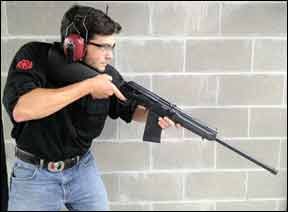
So, with a fresh production gun in our hands, we resumed testing. Because different types of loads can be placed on either side, the shooter can switch between tubes depending on his needs (e.g., one tube of buckshot loads and one tube of slugs). The shooter manually selects which magazine to use by switching a 3-position lever, located behind the pistol grip. If the selector is in the middle, the gun merely ejects the round and doesnt pop out another shell. Turning the lever to one side brings the magazine on that side into the feed cycle. When one magazine is empty, the shooter manually changes the feed direction by switching the lever. The shooter loads rounds one by one through the large loading/ejection port located at the bottom of the gun behind the pistol grip. Empty shells are ejected straight down through the same port.
Flipping between the two magazine tubes is not the smoothest thing, we found. You cant be casual about it. It takes a hard push to make the selector click over every time. To cycle the action, the shooter has to pull the polymer forend back and forth, ejecting the spent shell and loading a fresh one. A swinging wedge located inside the top of the bolt engages the barrel extension, locking the barrelf. Dual operating bars connect the sliding forend to the bolt.
The stock is made of glass-reinforced nylon (Zytel), and it has a smooth texture to it, which is important because the gun rubs your face while youre working the pump and shooting. The rubber buttpad was thick enough to be comfortable, even with magnums.
The gun was outfitted with two Picatinny rails, a plastic grooved rail on the foregrip and a metal one that runs along the top of the gun. The KSG does not ship with sights, so we shot it that way initially. Much to our surprise, the gun was very easy to shoot without sights. We were able to hit zombie pig targets with slugs up to 25 yards away. We also shot the gun without a vertical foregrip. While the gun will function without a vertical foregrip, it was not nearly as easy to work.
Our Team Said: On the second gun, we had only one failure to feed after shooting several hundred additional rounds. Because its a pump, it doesnt require the same level of maintenance as gas systems on the semi-autos do, and it will shoot and cycle just about anything of any power level you stuff in it, unlike the Saiga. We didnt like that the KSG ejects spent shells straight down into your pump arm, and we learned that we preferred working it with a grip.
With a laser/light front grip and an EOTech holographic sight fitted on this weapon, the KSG would be ready for just about anything from contact distance out to 50 yards, enabling the shooter to engage with shotshells and slugs at will. There are many good fighting shotguns on the market, but no others are quite as handy and possess as much firepower as the Kel-Tec KSG.
Saiga IZ-107 12 Gauge, $640
The Saiga-12 is a Kalashnikov-pattern 12-gauge combat shotgun. Like the Kalashnikov rifle variants, it is a rotating bolt, gas-operated gun that feeds from a box magazine. Saiga-12s are recognizable as Kalashnikov-pattern guns by the large lever-safety on the right side of the receiver, the optic mounting rail on the left side of the receiver, and the large top-mounted dust cover held in place by the rear of the recoil spring assembly. As we noted earlier, our test shotgun was imported into the US by European American Armories, although their agreement expired in 2005 and Izhmash is now exporting through the Russian-American Armory Company. Izhmash also manufactures Saiga 20 gauges and .410 bore shotguns, as well as the Saiga semi-automatic hunting rifles in a number of centerfire calibers.
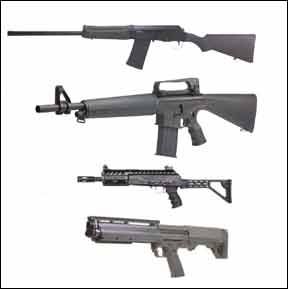
NIB Saigas like ours were recently listed at GunAuction.com with buy it now prices of $600. Or if you prefer, you can order a test gun similar to, if not identical to, Saigas carried by K-Var Corp. with the model number and price listed above. Our test shotgun and several extra magazines came from Fountain Firearms in Houston, FountainFirearms.com.
Other similar models listed by K-Var include the IZ-108 (19-inch barrel, adjustable sight, $670), the IZ-109 (19-inch barrel, $640), and the IZ-122 (24-inch barrel, adjustable sight, $650). Most retail versions of the Saigas ship with one five-round Russian magazine, cleaning kit, cleaning brush, oil bottle, & Saiga adjustment tool.
Our test shotgun was manufactured at the Izmash Legion Factory in Russia, utilizing the Kalashnikov gas system. This gas system reduces felt recoil and is capable of shooting in either single-shot operation, allowing use of all the gases to increase the velocity of the round, or in the standard semi-auto mode. It will shoot both 23⁄4-inch and 3-inch magnum shotshells, using an adjustable two-position gas system. Using the higher setting prevents high-power loads, such as slugs and buckshot, from damaging the receiver.The looser clearances offered in an AK design result in high reliability, which we saw in our testing. We had no function failures of any type with the Saiga, even though we used several different magazines with different capacities, including a massive drum magazine.
Though we loved the Saigas reliability, there are some nits to pick. The metalwork is rough and sharp, especially on the mount on the left side of the receiver. The lack of a rubber buttpad makes the stock slip around in the shoulder socket and does nothing to soften recoil.The trigger pull isnt overly heavy at 6.6 pounds, but it has about a half-inch of takeup before creeping toward release. The rear sight was crudely fashioned and was only drift-adjustable in a machined-in slot in the barrel. If we were buying new, wed pick an adjustable sight version for just a few dollars more.
Our Team Said: Despite its flaws, the Saiga 12 gauge is a hoss thats affordable. It accepts stick magazines up to 30 rounds that make it faster to fire and reload than the KSG, and it cycled with a 50-round drum magazine if it came down to fighting off a horde of zombies. Its a lot of gun for the money, in our opinion.



























